
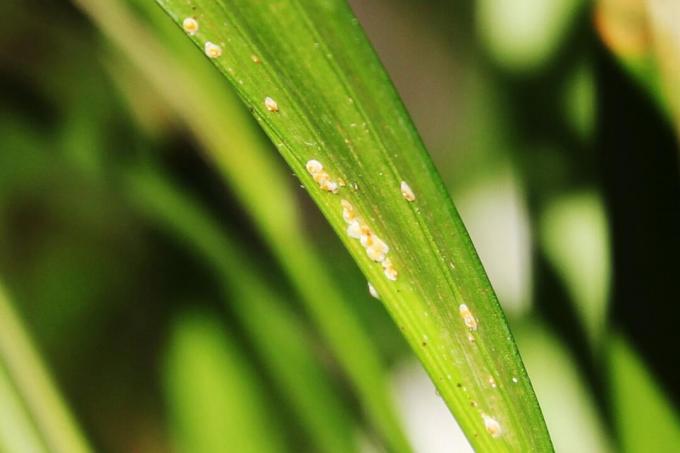
Table of contents
- Scale insects (Coccoidea)
- damage picture
- shower off
- collect
- brush off
- home remedies
- Mixtures for spraying
- spray mixtures
Scale insects not only cause a lot of damage, they are also particularly stubborn. Therefore, you should fight the insects immediately. Wait, the entire plant will soon be covered with plant lice.
Scale insects (Coccoidea)
Scale insects are plant lice (Sternorrhyncha). Of the 3,000 species known to date, around 90 live in Central Europe. Since they feed on the sap of plants, they are pests for the gardener. The size of the insects is between 0.8 and 6 millimeters. Therefore, with the naked eye, they are often not perceived as animals, but as brown dots.
This impression is created by the shield that protects the mostly immobile females. But it also serves as protection for the eggs that are laid underneath the shield shell. The larvae hatch from these, spread over the host plant, develop into females and in turn provide offspring. Males are not absolutely necessary for this, since scale insects can spread through the so-called virgin generation (parthenogenesis) can multiply.
damage picture
In addition to the "brown dots" mentioned, the infestation can also be detected on the so-called detect honeydew. This is a sticky, clear coating that the animals excrete. Because it contains sugar, it attracts other insects such as ants and wasps.
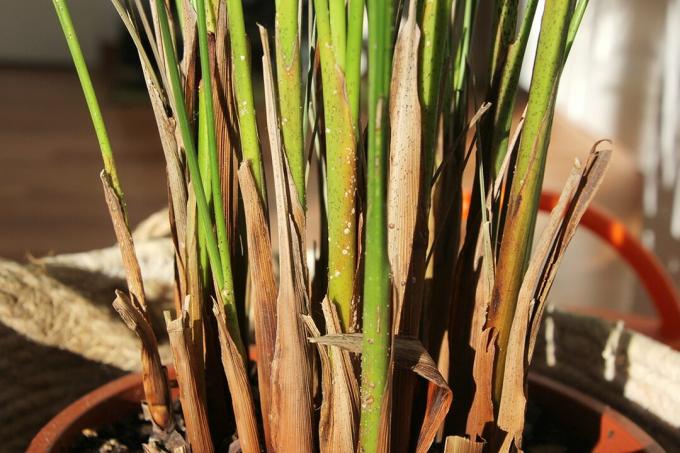
In addition, it can lead to the formation of sooty mold. Since it feeds on honeydew, it is not counted among the parasites. However, its greyish-black coating can limit the photosynthesis of the plants, which in turn damages them.
shower off
Showering off an infested plant is often recommended. However, the effect of this home remedy is questionable, because it can happen that the eggs of the scale insects are distributed. That's why you should use the houseplant
- if possible upside down
- shower with a strong jet
Tip:
The effectiveness of showering is controversial for animals that are already stuck, as the water jet is too weak.
collect
Although this method is tedious, it is promising if all lice are discovered and collected:
- collect with a sharp knife or tweezers
- definitely don't scrape
- Clean tools in between soak in alcohol
brush off
A toothbrush dipped in soapy water is best for brushing off plant lice. Because with this you can also reach specimens that are in hard-to-reach places on the plant.
home remedies
Alum (Potassium Aluminum Sulfate)
- Mix 100 grams of alum powder with half a liter of warm water
- Dilute the mixture with four liters of water just before use
- Apply to scale insects with a cotton swab
- apply daily
- Do not wet plant parts
nicotine
Nicotine promises a successful fight against plant lice, but should no longer be used nowadays due to its toxicity.
- Pour a liter of hot water over 150 to 200 grams of tobacco
- leave to stand in a closed jar for an hour
- Brush on scale insects
- Dab off preferred shoots thoroughly
- Spray insensitive plants
- Repeat treatment every two days
rapeseed oil
- remove visible scale insects
- brush affected areas
olive or paraffin oil
- Brush plant lice with a thin layer of oil twice a day for two weeks
- Combine treatment with other home remedies
tea tree oil
Apply the oil daily to the plant lice’s shell with a cotton swab. Be careful not to squirt the leaves, as the pungent tea tree oil can damage the plant.
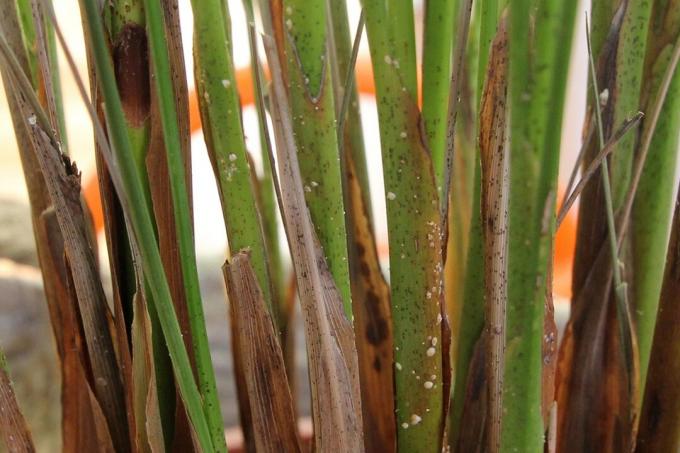
Mixtures for spraying
Curd soap, alcohol and water mixture
- one liter of water with 15 milliliters each of liquid curd soap and denatured alcohol
- Leave for 30 minutes
- Spray on, brush on or wipe over the affected parts of the plant with a cloth
- repeated regularly over a longer period of time
- alternatively: Brush plant lice with a cotton swab
A notice:
Before you use the curd soap-alcohol mixture, you should try it on a leaf, as not all plants tolerate this home remedy.
alcohol-water mixture
- Mix three parts water with one part high-proof alcohol (alternatively: spirit)
- Apply to the plant lice with a cotton swab
- destroys the protective shell, resulting in the death of the pests
Mixture of detergent, vinegar and water
- Mix some dish soap with water and vinegar
- spray the plant
- leave on for a few hours
- shower off the crop
spray mixtures
nettle
- Put 500 grams of crushed nettle in a bowl with five liters of hot water
- leave to rest for three days with the lid closed
- stir occasionally with a wooden stick
- filter the finished brew
- Spray the plant and scale insects once a week
Alternatively:
- 200 grams of fresh or 20 grams of dried nettle leaves
- shred
- douse with cold water
- Close container airtight
- leave for eight hours
- strain
- use
A notice:
Since nettle stock develops an extremely penetrating smell, preparation and use should only take place in the garden.
fern
- Pour 1 liter of boiling water over 100 grams of fresh or 10 grams of dried fern
- Dilute with ten liters of water just before use
- Spray the plant generously
- repeat weekly
Nasturtium
- Put 200 grams of nasturtium in a liter of boiling water
- boil for a few minutes
- Leave for 30 minutes
- strain
- Dilute with two liters of water just before use
- Spray the plant over a large area weekly
Garlic
- Pour 1.5 liters of boiling water over 50 grams of chopped garlic
- Leave for 30 minutes
- drain and let cool
- spray plant
Tip:
If the infestation is low, garlic cloves stuck in the ground can help.
baking soda
- Dissolve half a teaspoon of baking soda in a liter of water
- spray plant
Tip:
The effects of this home remedy are enhanced if you add a dash of alcohol or vegetable oil.
oregano
- Pour 1 liter of boiling water over 100 grams of fresh or 10 grams of dried oregano
- Leave for 15 to 20 minutes
- sieve
- Dilute with three liters of water
- Use sprays weekly
tansy
- Finely chop 150 grams of fresh tansy
- put in a large container
- Pour in five liters of hot water
- let steep for about ten minutes
- drain and let cool
- Spray the plant generously
- at least three times a week
vermouth
- Pour five liters of boiling water over 150 grams of fresh, crushed vermouth
- Leave for 30 minutes
- strain
- Spray the plant with the cooled brew
Onion
- Divide onion into smaller pieces
- boil in water
- Cover and leave to simmer for about 25 minutes
- strain after cooling
- Spray the plant well
 garden editorial
garden editorial I write about everything that interests me in my garden.
Learn more about crop protection
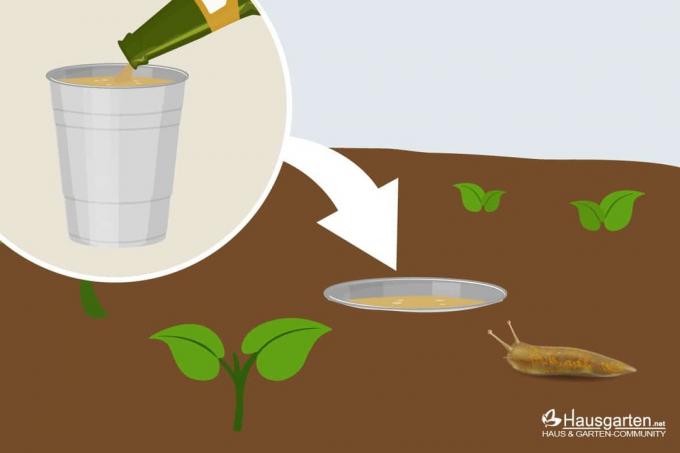
Beer trap against snails | Build it yourself or let it be?
There are several ways to banish snails from your garden beds, one of which is the beer trap. The animals smell the yeast contained in the beer and crawl into the trap and are supposed to drown in it. The alcohol in beer is also toxic.

Build your own snail trap 5 tips for the garden
Snails can cause considerable damage, especially to young plants and new shoots. Building a snail trap yourself can prevent this. But what should be used as bait and how should the snail traps be constructed? We show it here.

Fighting voles in the garden: 14 tips
Controlling voles in the garden can be tedious and frustrating. With the right tools and measures, however, the effort is significantly reduced while the chances of success increase. These can also be biological and gentle so as not to pose a burden on the environment and other animals.

Identify and control clothes moths
Identifying and fighting clothes moths is comparatively easy with the right knowledge. Above all, a nest, eggs or even larvae can be quickly eliminated by appropriate measures. In addition, they can be easily prevented. Our guide shows you how.

Cockroaches in the apartment: where do they come from and what helps?
Cockroaches in the apartment are a horror. The cockroaches are carriers of numerous pathogens and can multiply rapidly within a short period of time. To prevent an infestation, you must know the causes of the settlement or fight the insects.
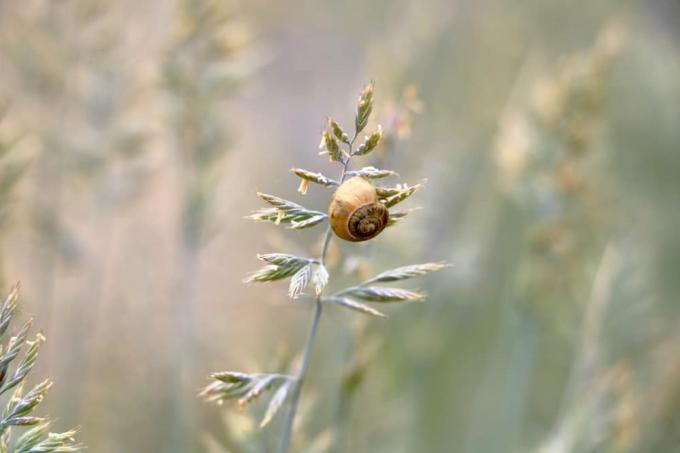
Snail fence: copper or plastic? Which effectively helps
A snail fence is a very effective means of controlling snails. You install the fence around the plants or beds you want to protect. Fences come in a variety of materials and sizes, with copper and plastic being common choices.



